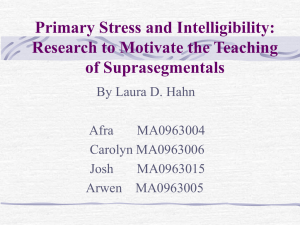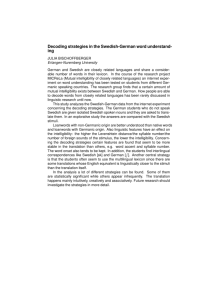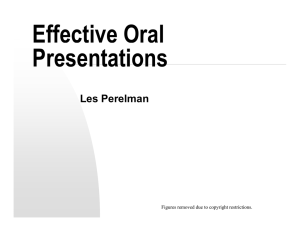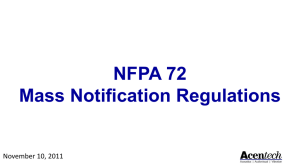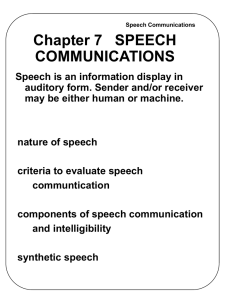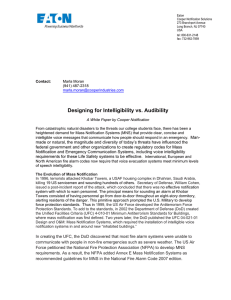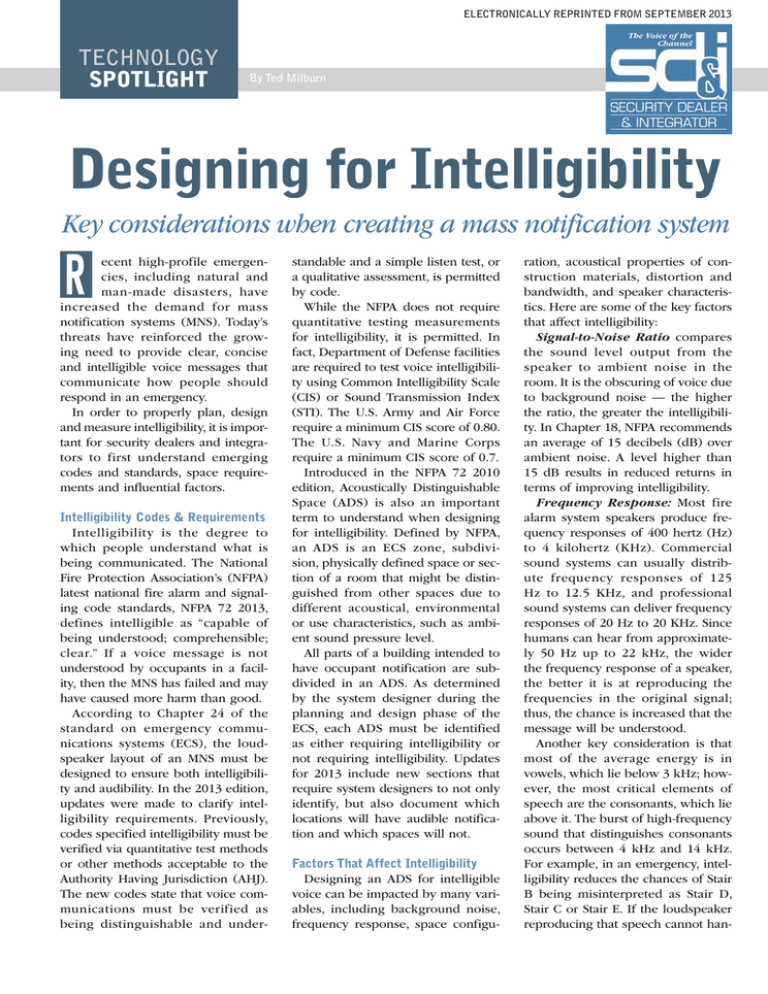
ELECTRONICALLY REPRINTED FROM SEPTEMBER 2013
TECHNOLOGY
SPOTLIGHT
By Ted Milburn
Designing for Intelligibility
Key considerations when creating a mass notification system
R
ecent high-profile emergencies, including natural and
man-made disasters, have
increased the demand for mass
notification systems (MNS). Today’s
threats have reinforced the growing need to provide clear, concise
and intelligible voice messages that
communicate how people should
respond in an emergency.
In order to properly plan, design
and measure intelligibility, it is important for security dealers and integrators to first understand emerging
codes and standards, space requirements and influential factors.
Intelligibility Codes & Requirements
Intelligibility is the degree to
which people understand what is
being communicated. The National
Fire Protection Association’s (NFPA)
latest national fire alarm and signaling code standards, NFPA 72 2013,
defines intelligible as “capable of
being understood; comprehensible;
clear.” If a voice message is not
understood by occupants in a facility, then the MNS has failed and may
have caused more harm than good.
According to Chapter 24 of the
standard on emergency communications systems (ECS), the loudspeaker layout of an MNS must be
designed to ensure both intelligibility and audibility. In the 2013 edition,
updates were made to clarify intelligibility requirements. Previously,
codes specified intelligibility must be
verified via quantitative test methods
or other methods acceptable to the
Authority Having Jurisdiction (AHJ).
The new codes state that voice communications must be verified as
being distinguishable and under-
standable and a simple listen test, or
a qualitative assessment, is permitted
by code.
While the NFPA does not require
quantitative testing measurements
for intelligibility, it is permitted. In
fact, Department of Defense facilities
are required to test voice intelligibility using Common Intelligibility Scale
(CIS) or Sound Transmission Index
(STI). The U.S. Army and Air Force
require a minimum CIS score of 0.80.
The U.S. Navy and Marine Corps
require a minimum CIS score of 0.7.
Introduced in the NFPA 72 2010
edition, Acoustically Distinguishable
Space (ADS) is also an important
term to understand when designing
for intelligibility. Defined by NFPA,
an ADS is an ECS zone, subdivision, physically defined space or section of a room that might be distinguished from other spaces due to
different acoustical, environmental
or use characteristics, such as ambient sound pressure level.
All parts of a building intended to
have occupant notification are subdivided in an ADS. As determined
by the system designer during the
planning and design phase of the
ECS, each ADS must be identified
as either requiring intelligibility or
not requiring intelligibility. Updates
for 2013 include new sections that
require system designers to not only
identify, but also document which
locations will have audible notification and which spaces will not.
Factors That Affect Intelligibility
Designing an ADS for intelligible
voice can be impacted by many variables, including background noise,
frequency response, space configu-
ration, acoustical properties of construction materials, distortion and
bandwidth, and speaker characteristics. Here are some of the key factors
that affect intelligibility:
Signal-to-Noise Ratio compares
the sound level output from the
speaker to ambient noise in the
room. It is the obscuring of voice due
to background noise — the higher
the ratio, the greater the intelligibility. In Chapter 18, NFPA recommends
an average of 15 decibels (dB) over
ambient noise. A level higher than
15 dB results in reduced returns in
terms of improving intelligibility.
Frequency Response: Most fire
alarm system speakers produce frequency responses of 400 hertz (Hz)
to 4 kilohertz (KHz). Commercial
sound systems can usually distribute frequency responses of 125
Hz to 12.5 KHz, and professional
sound systems can deliver frequency
responses of 20 Hz to 20 KHz. Since
humans can hear from approximately 50 Hz up to 22 kHz, the wider
the frequency response of a speaker,
the better it is at reproducing the
frequencies in the original signal;
thus, the chance is increased that the
message will be understood.
Another key consideration is that
most of the average energy is in
vowels, which lie below 3 kHz; however, the most critical elements of
speech are the consonants, which lie
above it. The burst of high-frequency
sound that distinguishes consonants
occurs between 4 kHz and 14 kHz.
For example, in an emergency, intelligibility reduces the chances of Stair
B being misinterpreted as Stair D,
Stair C or Stair E. If the loudspeaker
reproducing that speech cannot han-
TECHNOLOGY
SPOTLIGHT
All photos courtesy Cooper Notification
Top: Mass Notification systems are particularly useful
in school and other campus
situations, where a voice
message must be quickly
distributed among a large
number of people.
Above: Many poor evacuation systems are the result
of trying to compensate
for an insufficient amount
of speakers with too much
volume.
Left: When designing an
outdoor mass notification
system, be sure to account
for wind, temperature,
humidity and changes
resulting from time and
season.
dle certain frequencies, some of the
information will be lost. According
to the NFPA, an ADS that differs from
another space because of frequency
and level of ambient noise might
require speakers and system components that have a wider frequency
bandwidth.
Physical Room Characteristics:
Room reverberation depends on the
physical characteristics of the space,
such as room dimensions, construction materials, occupants and furnish-
ings. NFPA states that the amount of
reverberation in a room diminishes
when the room includes construction features, people or furnishings
that absorb sound. To reduce reverberation, designers should locate
loudspeakers away from hard surfaces and point the speakers towards
soft, absorbent surfaces.
Designing for intelligibility must
include collaboration between the
system designer, architect and interior designer. The ECS designer
should have an understanding of the
acoustics of the architectural design.
According to the Fire Protection
Research Foundation 2008 Report,
“Intelligibility of Fire Alarm and
Emergency Communication
Systems,” designers will need to
know all room dimensions, use,
occupancy, finishes and treatments,
as well as speaker polar plots. A
design analysis could reveal that an
intelligible system is not achievable
unless some features of the architecture are changed.
Design Trends
An intelligibility report developed by the National Electrical
Manufacturers Association (NEMA),
states that designers and engineers
have the greatest effect on speech
intelligibility by their choice of
equipment; the number, distribution and placement of loudspeakers;
and the power at which they are
driven. According to NFPA, in order
to achieve an intelligible voice message in certain situations, a distributed sound level with minimal sound
intensity variations is required, which
differs from past fire alarm design. It
is not simply a matter of turning up
the volume or increasing the speaker
wattage. Many poor evacuation systems are the result of trying to compensate for an insufficient amount of
speakers with too much volume.
The rule of thumb for enhanced
intelligibility is increasing the number of speakers and using the lower
tap settings instead of increasing the
sound output — as increasing the
wattage of a speaker can often distort the message. Optimizing intelligibility can equate to as much as
eight times as many speakers used
just to achieve audibility.
The deal point-source (speaker to
listener) is 20 feet or less. Ceiling
height should be speaker spacing.
For example, if the ceiling is 12 feet
high, space the speakers 12 feet
apart for intelligibility, as opposed to
24 feet apart for audibility.
Designing for Outdoor Areas
The same principles also pertain
to designing intelligible systems
for outdoor areas; however, there
are additional parameters to consider such as wind, temperature and
humidity, as well as the changing of
the environment due to seasons, age
and time.
For example, vegetation growth
affects sound. Designing a wide-area
MNS in the middle of winter when
trees are bare without considering
trees in full bloom, can greatly affect
the intelligibility of the system.
Referring to NFPA 72 2013, consulting a sound professional and
utilizing commercially available software tools are recommended when
designing spaces and rooms for voice
intelligibility. It is also important to
note to include all stakeholders as
part of the design process, such as
the architect, interior designer and
the AHJ. ❚
Ted Milburn is VP of marketing for Eaton’s
Cooper Notification Business. Learn more at
www.securityinfowatch.com/10215756.
Posted with permission from September 2013. Security Dealer and Integrator, Cygnus Business Media. Copyright 2013. All rights reserved.
For more information on the use of this content, contact Wright’s Media at 877-652-5295
105610




